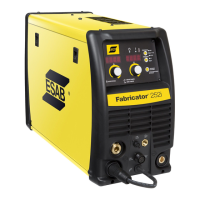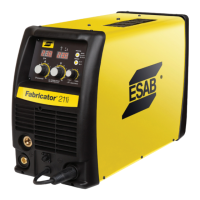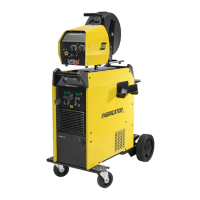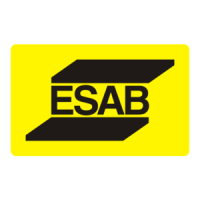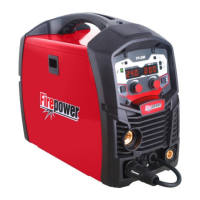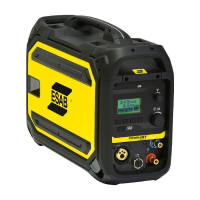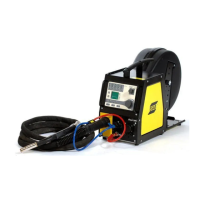ESAB FABRICATOR 141i
BASIC WELDING GUIDE 4-12 Manual 0-5420
Art # A-10368
1/16" (1.6mm)
Figure 4-20: Striking an Arc
Arc Length
The securing of an arc length necessary to produce a neat
weld soon becomes almost automatic. You will find that a long
arc produces more heat. A very long arc produces a crack-
ling or spluttering noise and the weld metal comes across in
large, irregular blobs. The weld bead is flattened and spatter
increases. A short arc is essential if a high quality weld is to be
obtained although if it is too short there is the danger of it be-
ing blanketed by slag and the electrode tip being solidified in. If
this should happen, give the electrode a quick twist back over
the weld to detach it. Contact or "touch-weld" electrodes such
as E7014 Stick electrodes do not stick in this way, and make
welding much easier.
Rate of Travel
After the arc is struck, your next concern is to maintain it, and
this requires moving the electrode tip towards the molten pool
at the same rate as it is melting away. At the same time, the
electrode has to move along the plate to form a bead. The
electrode is directed at the weld pool at about 20º from the
vertical. The rate of travel has to be adjusted so that a well-
formed bead is produced.
If the travel is too fast, the bead will be narrow and strung
out and may even be broken up into individual globules. If the
travel is too slow, the weld metal piles up and the bead will be
too large.
Making Welded Joints
Having attained some skill in the handling of an electrode, you
will be ready to go on to make up welded joints.
A. Butt Welds
Set up two plates with their edges parallel, as shown in
Figure 4-21, allowing 1/16"(1.6mm) to 3/32"(2.4mm)
gap between them and tack weld at both ends. This is to
prevent contraction stresses from the cooling weld metal
pulling the plates out of alignment. Plates thicker than 1/4"
(6.4mm) should have their mating edges beveled to form a
70º to 90º included angle. This allows full penetration of the
weld metal to the root. Using a 1/8"(3.2mm) E7014 Stick
electrode at 100 amps, deposit a run of weld metal on the
bottom of the joint.
Do not weave the electrode, but maintain a steady rate of
travel along the joint sufficient to produce a well-formed
bead. At first you may notice a tendency for undercut to form,
but keeping the arc length short, the angle of the electrode at
about 20º from vertical, and the rate of travel not too fast, will
help eliminate this. The electrode needs to be moved along
fast enough to prevent the slag pool from getting ahead of
the arc. To complete the joint in thin plate, turn the job over,
clean the slag out of the back and deposit a similar weld.
Art # A-07697_AB
Tack Weld
Electrode
Tack Weld
Figure 4-21: Butt Weld
Art # A-07698
Figure 4-22: Weld Build up Sequence
Heavy plate will require several runs to complete the joint.
After completing the first run, chip the slag out and clean the
weld with a wire brush. It is important to do this to prevent
slag being trapped by the second run. Subsequent runs are
then deposited using either a weave technique or single
beads laid down in the sequence shown in Figure 4-22. The
width of weave should not be more than three times the core
wire diameter of the electrode. When the joint is completely
filled, the back is either machined, ground or gouged out
to remove slag which may be trapped in the root, and to
prepare a suitable joint for depositing the backing run. If a
backing bar is used, it is not usually necessary to remove
this, since it serves a similar purpose to the backing run in
securing proper fusion at the root of the weld.
B. Fillet Welds
These are welds of approximately triangular cross-section
made by depositing metal in the corner of two faces meeting
at right angles. Refer to Figure 4-14.
A piece of angle iron is a suitable specimen with which to
begin, or two lengths of strip steel may be tacked together
at right angles. Using a 1/8"(3.2mm) E7014 Stick electrode
at 100 amps, position angle iron with one leg horizontal and
the other vertical. This is known as a horizontal-vertical (HV)
fillet. Strike the arc and immediately bring the electrode to
a position perpendicular to the line of the fillet and about
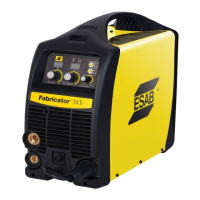
